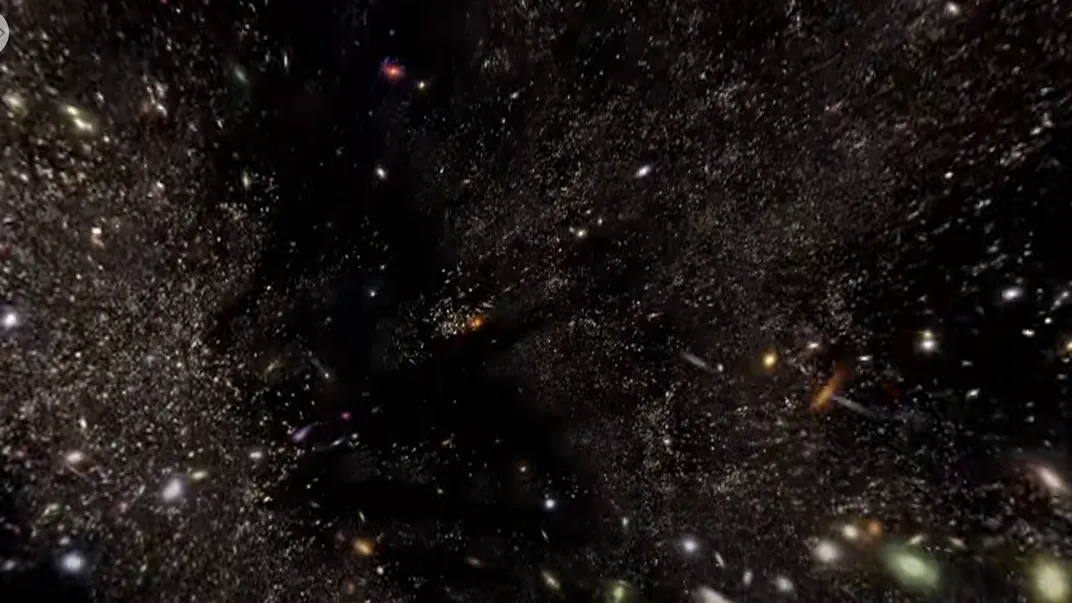Dark Energy Could Be Evolving Over Time, Raising Questions About the Nature of the Cosmos
The largest 3D map of the universe ever made hints that dark energy might not be a constant, though the findings must be backed up with more data
:focal(2000x1200:2001x1201)/https://tf-cmsv2-smithsonianmag-media.s3.amazonaws.com/filer_public/ea/d8/ead81125-df3b-468c-9cb9-804b41f8e3ab/noirlab2408b.jpg)
A new map of the universe hints at the shocking possibility that dark energy is evolving—a suggestion that, if confirmed, would have huge implications for the nature of the cosmos.
Dark energy is causing the universe to expand more rapidly over time—and it is considered a constant in the leading model of cosmology. While the researchers need to gather more data to make their early results more precise, their initial findings suggest that dark energy could work differently than previously thought.
“If this is true, this just turns cosmology upside down,” Dillon Brout, a cosmologist at Boston University who was not involved in the new research, tells Space.com’s Sharmila Kuthunur. A finding like this would be a “paradigm shift in our thinking of what our best understanding of our universe is.”
“If it holds up, this is a very big deal,” Adam Riess, an astrophysicist at Johns Hopkins University who led the team that discovered dark energy 25 years ago and did not contribute to the recent findings, says to New Scientist’s Leah Crane.
“It’s exciting,” Sesh Nadathur, a cosmologist at the University of Portsmouth in England who worked on the research, tells Quanta Magazine’s Charlie Wood. “If dark energy is not a cosmological constant, that’s going to be a huge discovery.”
The findings were shared in several new papers posted on the pre-print server arXiv that have not yet been peer reviewed and were presented in talks at a meeting of the American Physical Society on Thursday.
Scientists aren’t sure what dark energy is exactly, but it seems to make up 68 percent of the universe. Because astronomers have observed other galaxies getting farther away from us over time, they know the universe is expanding. Intuitively, the pull of gravity implies this expansion should be slowing down—but over the past 7.5 billion years, it’s been getting faster. Dark energy is the name for the unknown cause of this increasing rate of expansion.
The new research culminated in a 3D map that measures how the universe has been expanding over the past 11 billion years. The data was collected by the Dark Energy Spectroscopic Instrument (DESI), a part of the Nicholas U. Mayall Telescope at the Kitt Peak National Observatory in Arizona.
Five thousand tiny robots on the telescope collect data at an unprecedented rate, per a statement from the observatory. Since it started scanning the sky in 2021, DESI has observed 5,000 galaxies every 20 minutes, totaling more than 100,000 galaxies each night.
The new map, based on just the first year of DESI’s data, is the largest 3D map of the universe ever made, according to a statement from the Lawrence Berkeley National Laboratory (Berkeley Lab), which manages the project.
“DESI is a really great experiment producing stupendous data,” Riess tells Quanta Magazine.
/https://tf-cmsv2-smithsonianmag-media.s3.amazonaws.com/filer_public/9d/85/9d8581b9-eb46-49b2-93f7-81c6ff49b3b0/gettyimages-144081245.jpg)
DESI visualized how the universe has been expanding over time by mapping the distribution of galaxies. The researchers used subtle wrinkles in the early universe called baryon acoustic oscillations to measure distances, since these patterns are a known size. They also used the predictable brightness of three supernova explosions to calculate the universe’s rate of expansion. But the results from each supernova sample showed a different rate from what the leading model of cosmology says, suggesting the current idea of the cosmos might not be accurate.
“We do see, indeed, a hint that the properties of dark energy would not correspond to a simple cosmological constant” but instead might “have some deviations,” Nathalie Palanque-Delabrouille, a Berkeley Lab astrophysicist and collaborator on the project, tells the New York Times’ Dennis Overbye. “And this is the first time we have that.”
But “I wouldn’t call it evidence yet,” she cautions to the publication. “It’s too, too weak.”
The team’s conclusion has a one-in-400 chance of being a statistical anomaly that doesn’t prove to be true. That’s lower than the typical threshold for a scientific discovery, which must have a lower than one-in-1.7-million chance of being a fluke, per the New York Times.
“There is a huge amount still to understand about this data, and early results should be taken with a healthy grain of salt,” Andrew Pontzen, a cosmologist at University College London who was not involved in the research, tells the Guardian’s Nicola Davis.
Still, the early results have caused a stir among physicists. The finding is “an adrenaline shot to the cosmology community,” Daniel Scolnic, a physicist at Duke University who did not contribute to the findings, says to Science News’ Emily Conover.
“If this holds up, it could light the way to a new, potentially deeper understanding of the universe,” Riess tells Quanta Magazine. “The next few years should be very revealing.”
/https://tf-cmsv2-smithsonianmag-media.s3.amazonaws.com/accounts/headshot/Will-Sullivan-photo.png)


/https://tf-cmsv2-smithsonianmag-media.s3.amazonaws.com/accounts/headshot/Will-Sullivan-photo.png)